Preanalytical Quality Evaluation of Citrate Evacuated Blood Collection Tubes—Ultraviolet Molecular Absorption Spectrometry Confronted with Ion Chromatography
Abstract
:1. Introduction
2. Results
2.1. Ion Chromatographic Method for Citrate Determination—Method Performance
2.2. Evacuated Blood Collection Tubes for Coagulation Tests—Anticoagulant Concentration Evaluation with the Two Methods
2.3. Evacuated Blood Collection Tubes for Coagulation Tests—Impurities and Additives Examination
2.3.1. Cations as Contaminants Examined with Cationic Ion Chromatography
2.3.2. Absorption Spectra and Chromatograms of Citrate Influenced by Heparin
3. Discussion
3.1. Ion Chromatographic Method for Citrate Determination—Method Performance
3.2. Evacuated Blood Collection Tubes for Coagulation Tests—Anticoagulant Concentration Evaluation with the Two Methods
3.3. Evacuated Blood Collection Tubes for Coagulation Tests—Impurities and Additives Examination
3.3.1. Cations as Contaminants Examined with Cationic Ion Chromatography
3.3.2. Absorption Spectra and Chromatograms of Citrate, Influenced by Heparin
3.3.3. Implications and Limitations
4. Materials and Methods
4.1. Trisodium Citrate, Purified Water, Evacuated Blood Collection Tubes, and Composite Samples
4.2. Ion Chromatography
4.2.1. Determination of Citrate with Ion Exclusion Chromatography
4.2.2. Determination of Cations with Ion Exchange Chromatography
4.3. Comparison of Molecular Absorption Spectrometry and Ion Chromatography for Citrate Determination in Evacuated Blood Collection Tubes
4.4. Heparin Influence on Absorption Spectra
5. Conclusions
Author Contributions
Funding
Institutional Review Board Statement
Informed Consent Statement
Data Availability Statement
Conflicts of Interest
References
- Winter, W.E.; Pittman, D.L.; Harris, N.S. Hematology and coagulation preanalytics for clinical chemists: Factors intrinsic to the sample and extrinsic to the patient. Clin. Biochem. 2023, 115, 3–12. [Google Scholar] [CrossRef] [PubMed]
- Lippi, G.; Cornes, M.P.; Grankvist, K.; Nybo, M.; Simundic, A.M.; European Federation Clinical, C. EFLM WG-Preanalytical phase opinion paper: Local validation of blood collection tubes in clinical laboratories. Clin. Chem. Lab. Med. 2016, 54, 755–760. [Google Scholar] [CrossRef]
- Gros, N. Pre-Analytical Within-Laboratory Evacuated Blood-Collection Tube Quality Evaluation. In Biochemical Testing: Clinical Correlation and Diagnosis; Bobbarala, V., Zaman, G.S., Desa, M.N.M., Akim, A.M., Eds.; IntechOpen: London, UK, 2018. [Google Scholar]
- Lippi, G.; Salvagno, G.L.; Biljak, V.R.; Kralj, A.K.; Kuktic, I.; Gelati, M.; Simundic, A.M. Filling accuracy and imprecision of commercial evacuated sodium citrate coagulation tubes. Scand. J. Clin. Lab. Investig. 2019, 79, 276–279. [Google Scholar] [CrossRef] [PubMed]
- Duncan, E.M.; Casey, C.R.; Duncan, B.M.; Lloyd, J.V. Effect of Concentration of Trisodium Citrate Anticoagulant on Calculation of the International Normalized Ratio and the International Sensitivity Index of Thromboplastin. Thromb. Haemost. 1994, 72, 84–88. [Google Scholar] [PubMed]
- Gros, N.; Klobučar, T.; Gaber, K. Accuracy of Citrate Anticoagulant Amount, Volume, and Concentration in Evacuated Blood Collection Tubes Evaluated with UV Molecular Absorption Spectrometry on a Purified Water Model. Molecules 2023, 28, 486. [Google Scholar] [CrossRef]
- Michalski, R.; Blazewicz, A.; Konczyk, J.; Krupa, K.; Nizinski, P. Ion Chromatography for Small Molecule Determination in Clinical and Pharmaceutical Studies. LC-GC Eur. 2019, 32, 629–634. [Google Scholar]
- DeBorba, B.M.; Rohrer, J.S.; Bhattacharyya, L. Development and validation of an assay for citric acid/citrate and phosphate in pharmaceutical dosage forms using ion chromatography with suppressed conductivity detection. J. Pharm. Biomed. Anal. 2004, 36, 517–524. [Google Scholar] [CrossRef]
- Jenke, D.; Sadain, S.; Nunez, K.; Byrne, F. Performance characteristics of an ion chromatographic method for the quantitation of citrate and phosphate in pharmaceutical solutions. J. Chromatogr. Sci. 2007, 45, 50–56. [Google Scholar] [CrossRef]
- Chen, Z.L.; Adams, M.A. Retention behavior and simultaneous separation of carboxylic and aromatic acids using ion-exclusion chromatography. J. Liq. Chromatogr. Relat. Technol. 1999, 22, 2595–2611. [Google Scholar] [CrossRef]
- Tanaka, K.; Chikara, H.; Hu, W.Z.; Hasebe, K. Separation of carboxylic acids on a weakly acidic cation-exchange resin by ion-exclusion chromatography. J. Chromatogr. A 1999, 850, 187–196. [Google Scholar] [CrossRef]
- Bowen, R.A.R.; Hortin, G.L.; Csako, G.; Otañez, O.H.; Remaley, A.T. Impact of blood collection devices on clinical chemistry assays. Clin. Biochem. 2010, 43, 4–25. [Google Scholar] [CrossRef] [PubMed]
- Bowen, R.A.R.; Remaley, A.T. Interferences from blood collection tube components on clinical chemistry assays. Biochem. Medica 2014, 24, 31–44. [Google Scholar] [CrossRef] [PubMed]
- Bowen, R.A.R.; Adcock, D.M. Blood collection tubes as medical devices: The potential to affect assays and proposed verification and validation processes for the clinical laboratory. Clin. Biochem. 2016, 49, 1321–1330. [Google Scholar] [CrossRef] [PubMed]
- Kosecki, P.A.; Autret, A.; Abbott, L.; Keller-Brooke, K. Isobutylene contamination of blood collected in 10-ml evacuated blood collection tubes with gray conventional rubber stoppers. J. Forensic Sci. 2021, 66, 2484–2492. [Google Scholar] [CrossRef]
- Borgatta, M.; Hechon, J.; Wild, P.; Hopf, N.B. Influence of collection and storage materials on glycol ether concentrations in urine and blood. Sci. Total Environ. 2021, 792, 148196. [Google Scholar] [CrossRef] [PubMed]
- Lima-Oliveira, G.; Brennan-Bourdon, L.M.; Varela, B.; Arredondo, M.E.; Aranda, E.; Flores, S.; Ochoa, P. Clot activators and anticoagulant additives for blood collection. A critical review on behalf of COLABIOCLI WG-PRE-LATAM. Crit. Rev. Clin. Lab. Sci. 2021, 58, 207–224. [Google Scholar] [CrossRef] [PubMed]
- Lima, M.A.; Rudd, T.R.; de Farias, E.H.C.; Ebner, L.F.; Gesteira, T.F.; de Souza, L.M.; Mendes, A.; Córdula, C.R.; Martins, J.R.M.; Hoppensteadt, D.; et al. A New Approach for Heparin Standardization: Combination of Scanning UV Spectroscopy, Nuclear Magnetic Resonance and Principal Component Analysis. PLoS ONE 2011, 6, e15970. [Google Scholar] [CrossRef]
- Miller, J.N.; Miller, J.C. Statistics and Chemometrics for Analytical Chemistry; Pearson Education Limited: Harlow, UK, 2010. [Google Scholar]
- Keppel, M.H.; Auer, S.; Lippi, G.; von Meyer, A.; Cornes, M.; Felder, T.K.; Oberkofler, H.; Mrazek, C.; Haschke-Becher, E.; Cadamuro, J. Heparin and citrate additive carryover during blood collection. Clin. Chem. Lab. Med. 2019, 57, 1888–1896. [Google Scholar] [CrossRef]
- Jeon, M.; Han, A.; Kang, H.; Lee, K.H.; Lee, J.H. A comparison of coagulation test results from heparinized central venous catheter and venipuncture. Blood Coagul. Fibrinolysis 2020, 31, 145–151. [Google Scholar] [CrossRef]
- Brown, J.M.; Dimeski, G. Contamination of coagulation tests with heparin from blood gas samples. Br. J. Anaesth. 2001, 87, 628–629. [Google Scholar] [CrossRef]
- Thiangthum, S.; Vander Heyden, Y.; Buchberger, W.; Viaene, J.; Prutthiwanasan, B.; Suntornsuk, L. Development and validation of an ion-exchange chromatography method for heparin and its impurities in heparin products. J. Sep. Sci. 2014, 37, 3195–3204. [Google Scholar] [CrossRef] [PubMed]
- Fasciano, J.M.; Danielson, N.D. Ion chromatography for the separation of heparin and structurally related glycoaminoglycans: A review. J. Sep. Sci. 2016, 39, 1118–1129. [Google Scholar] [CrossRef] [PubMed]
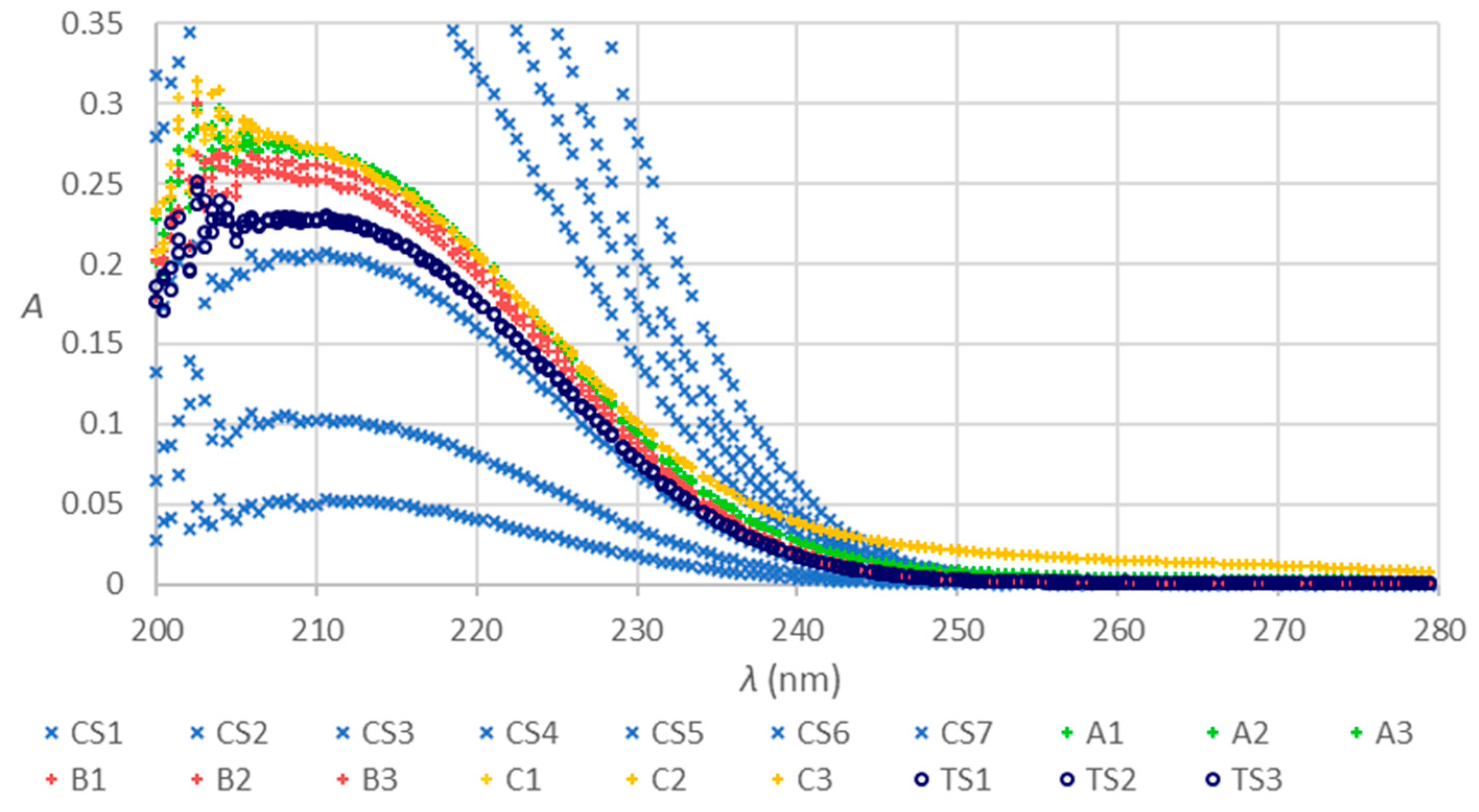
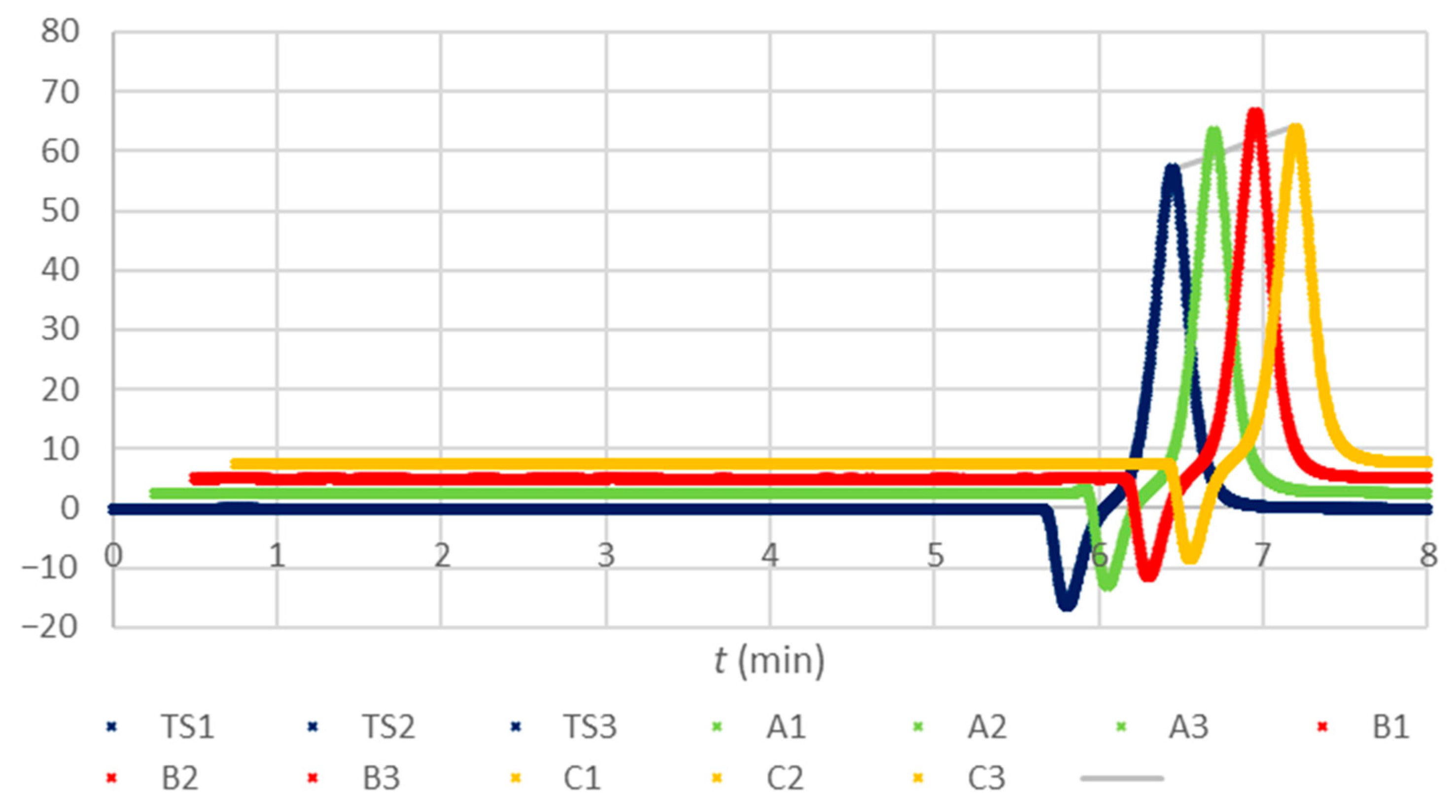
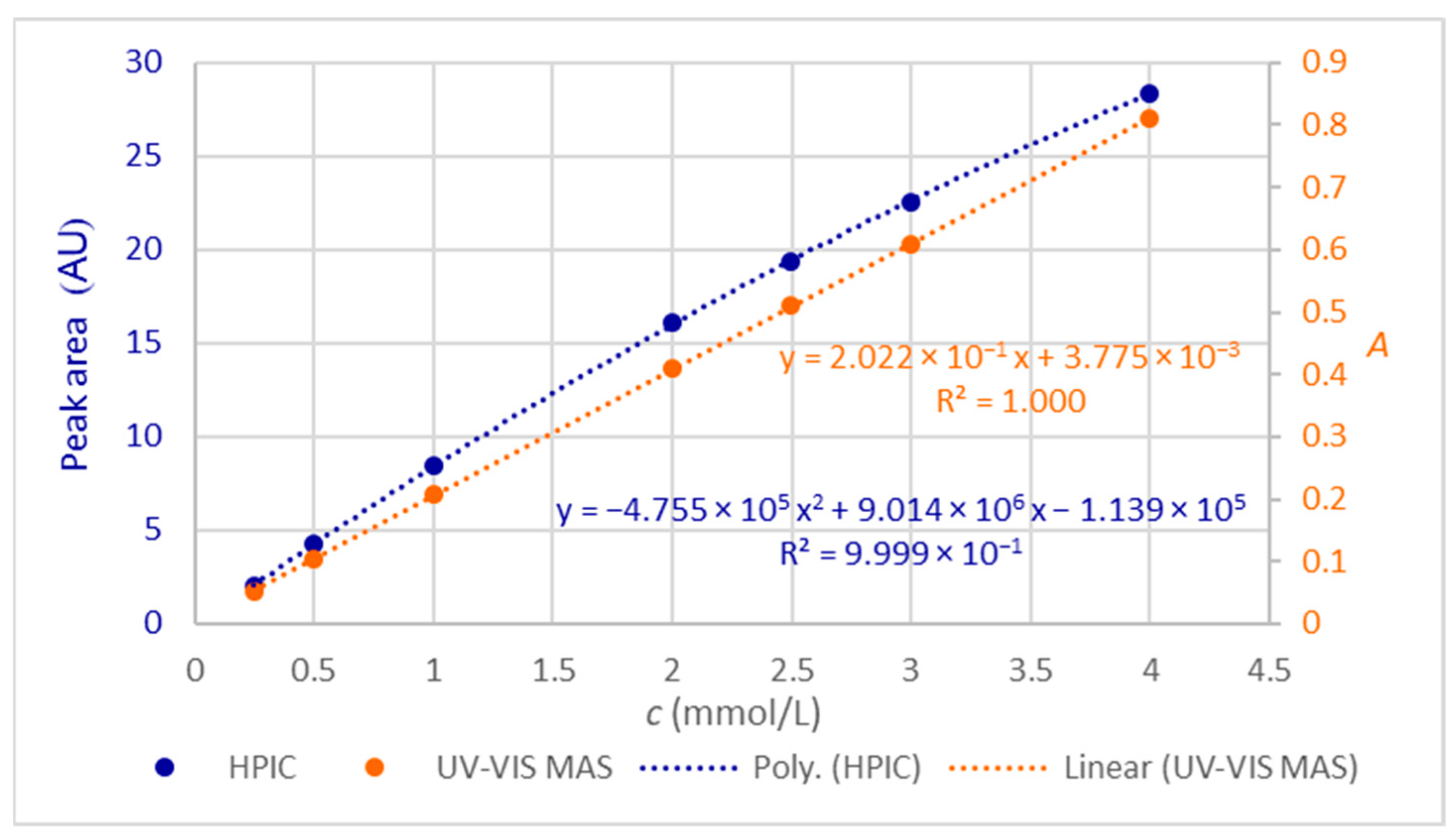
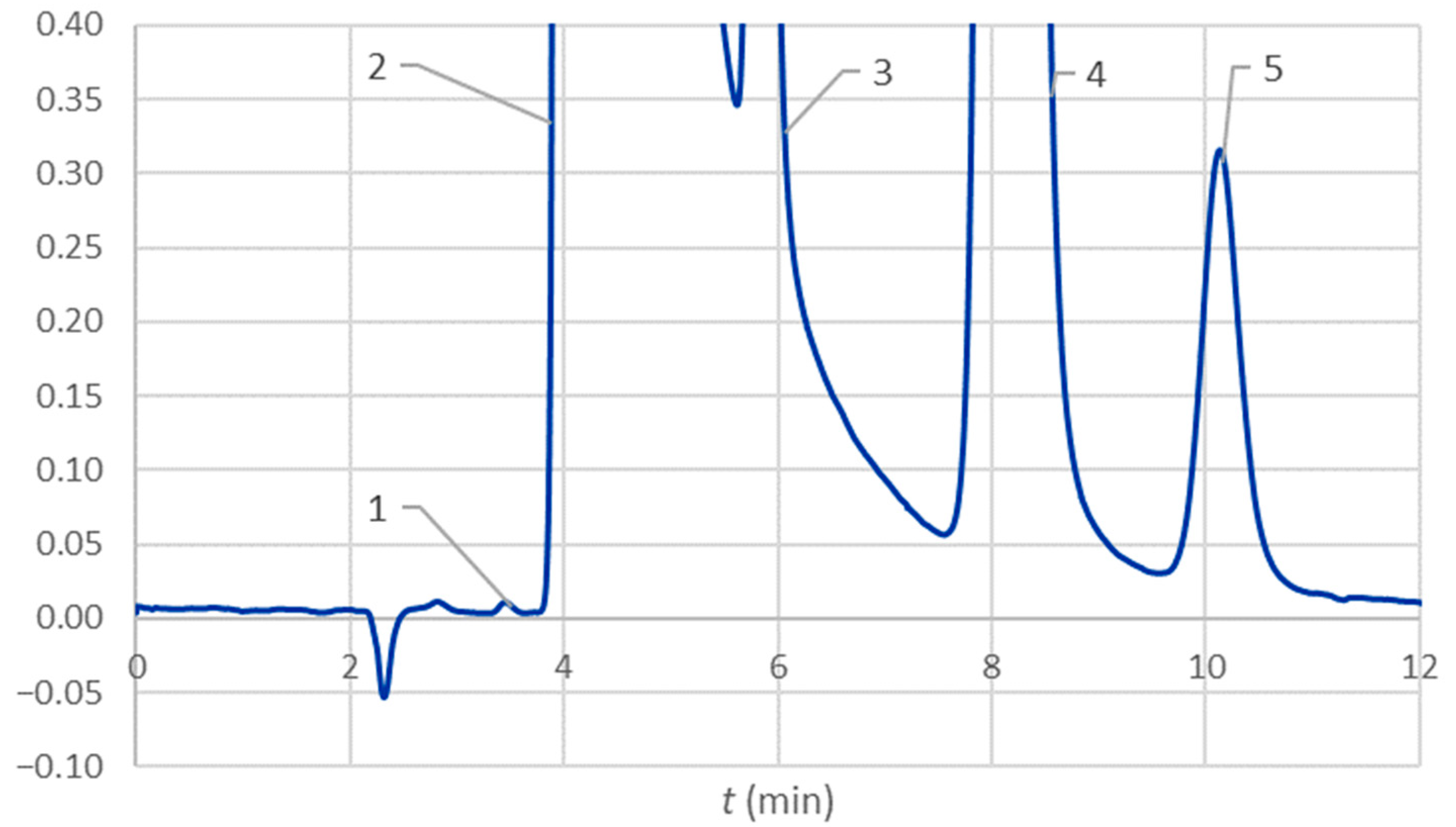
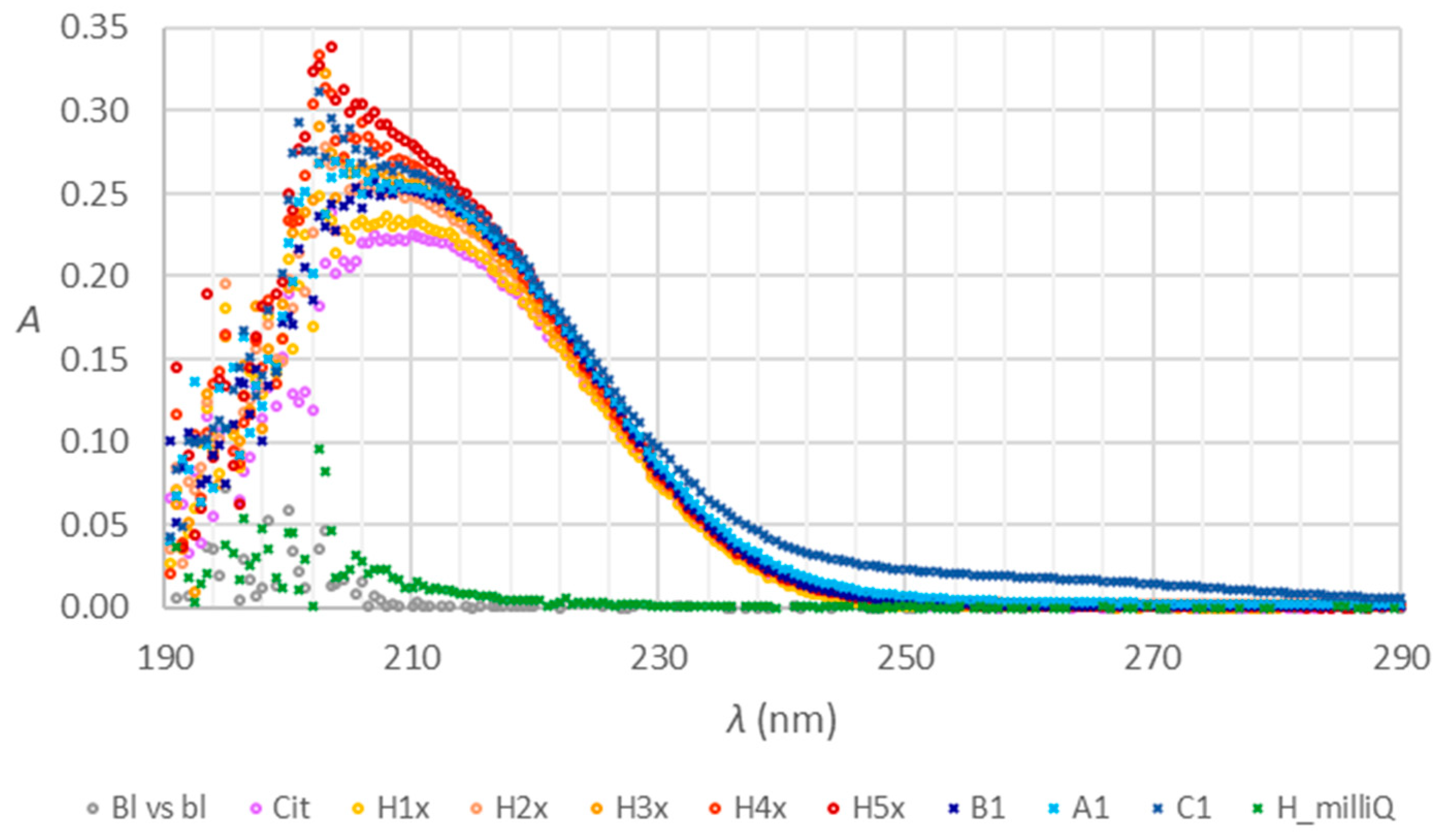
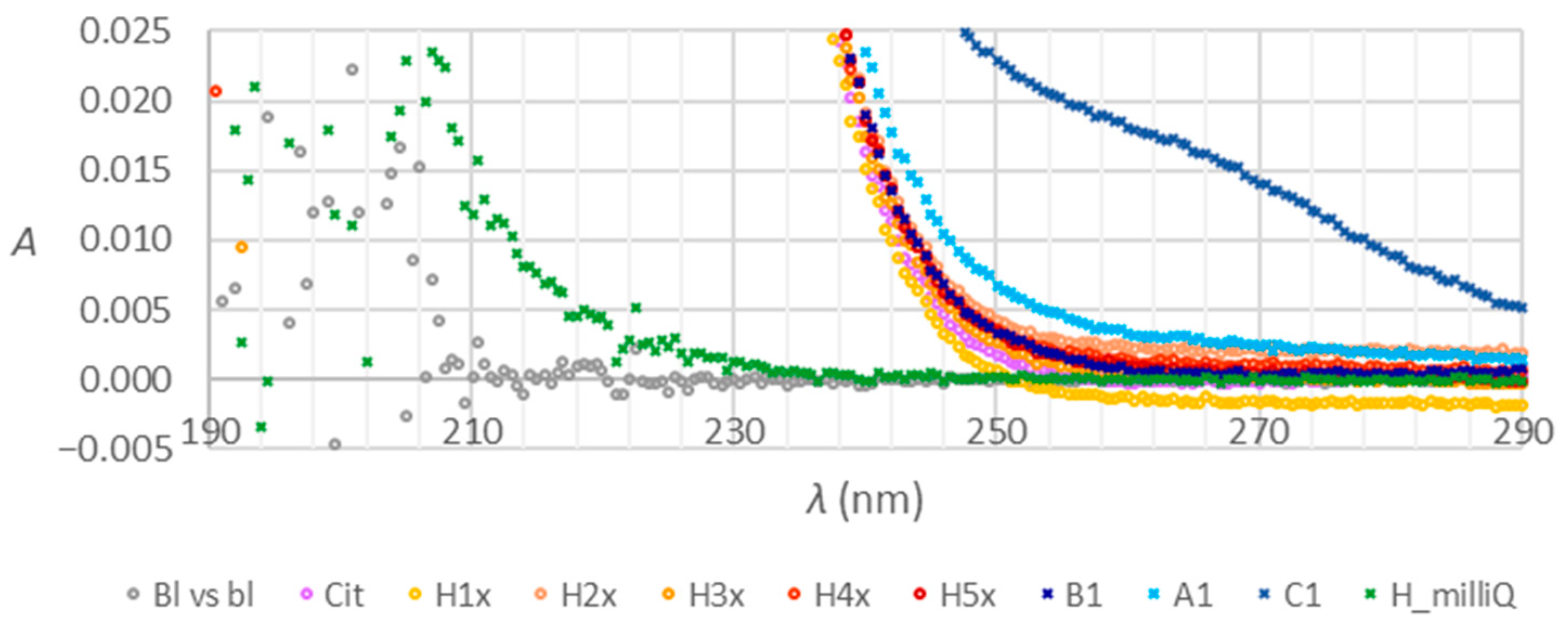
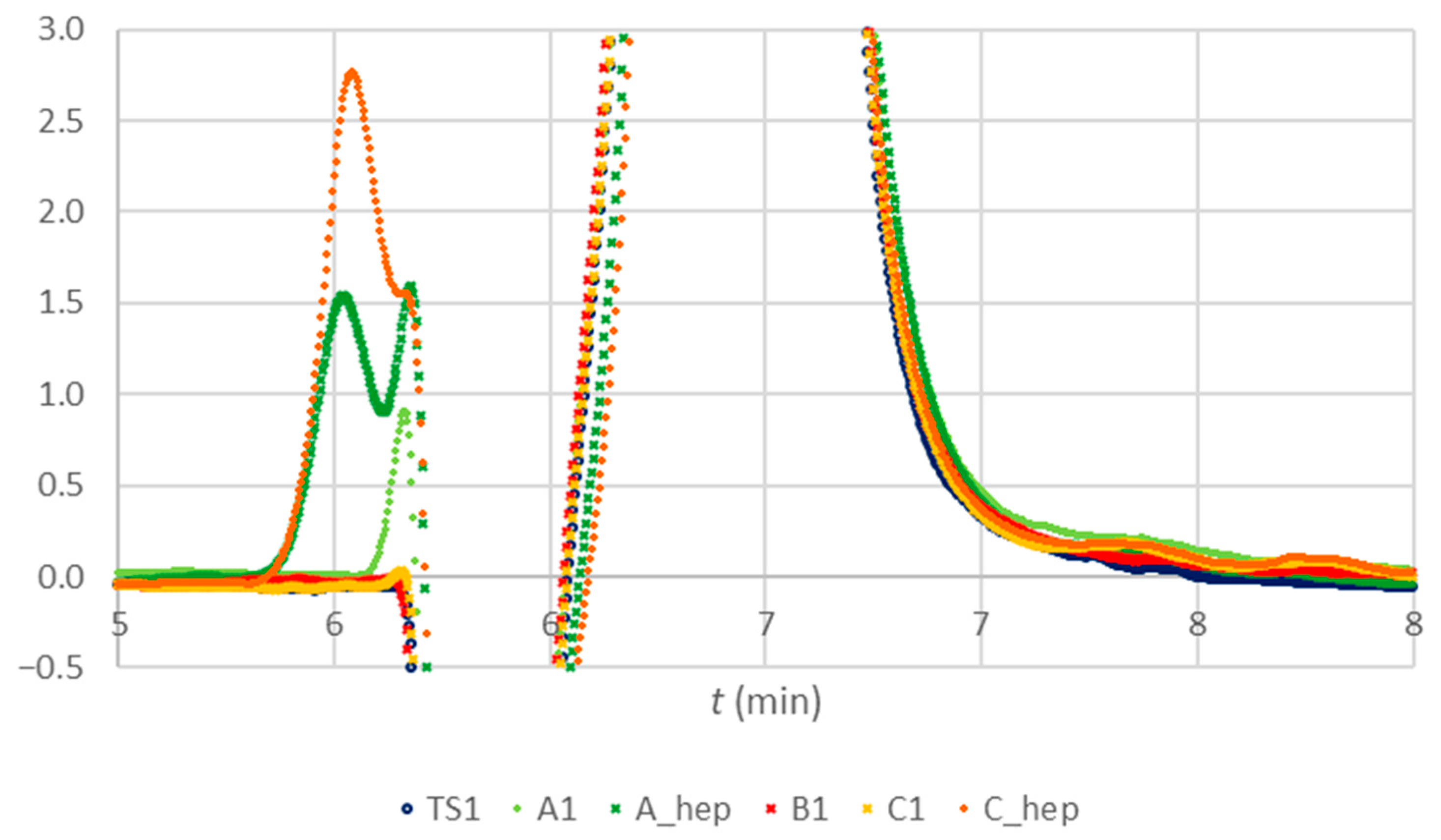

| Repetition | 1. | 2. | 3. | 4. | 5. | s | sr (%) | |
|---|---|---|---|---|---|---|---|---|
| c (mmol/L) | tr (min) | |||||||
| 0.25 | 6.40 | 6.43 | 6.43 | 6.39 | 6.39 | 6.41 | 0.02 | 0.3 |
| 2 | 6.52 | 6.54 | 6.53 | 6.54 | 6.53 | 6.53 | 0.01 | 0.1 |
| 4 | 6.59 | 6.56 | 6.59 | 6.60 | 6.60 | 6.59 | 0.02 | 0.2 |
| c (mmol/L) | Peak area (AU) | |||||||
| 0.25 | 2.199 × 106 | 2.201 × 106 | 2.206 × 106 | 2.187 × 106 | 2.195 × 106 | 2.198 × 106 | 7.0 × 103 | 0.32 |
| 2 | 1.601 × 107 | 1.597 × 107 | 1.595 × 107 | 1.600 × 107 | 1.592 × 107 | 1.597 × 107 | 3.8 × 104 | 0.24 |
| 4 | 2.780 × 107 | 2.768 × 107 | 2.762 × 107 | 2.771 × 107 | 2.774 × 107 | 2.771 × 107 | 6.6 × 104 | 0.24 |
| Date | a | sa | b | sb | c | sc | sy/x | R2 |
|---|---|---|---|---|---|---|---|---|
| 13 March 2023 | −4.98 × 105 | 3.50 × 104 | 8.85 × 106 | 1.47 × 105 | 8.89 × 104 | 1.22 × 105 | 1.28 × 105 | 0.9999 |
| 14 March 2023 | −4.86 × 105 | 4.21 × 104 | 8.85 × 106 | 1.77 × 105 | 9.18 × 104 | 1.46 × 105 | 1.54 × 105 | 0.9998 |
| 15 March 2023 | −5.03 × 105 | 3.41 × 104 | 9.11 × 106 | 1.43 × 105 | 5.91 × 104 | 1.19 × 105 | 1.25 × 105 | 0.9999 |
| 16 March 2023 | −4.84 × 105 | 4.36 × 104 | 9.10 × 106 | 1.83 × 105 | 1.16 × 105 | 1.52 × 105 | 1.60 × 105 | 0.9998 |
| 20 March 2023 | −4.87 × 105 | 2.74 × 104 | 9.04 × 106 | 1.15 × 105 | 4.15 × 103 | 9.54 × 104 | 1.00 × 105 | 0.9999 |
| 28 March 2023 | −4.38 × 105 | 2.86 × 104 | 8.16 × 106 | 1.20 × 105 | 2.72 × 105 | 9.96 × 104 | 1.05 × 105 | 0.9999 |
| 29 March 2023 | −4.79 × 105 | 3.63 × 104 | 8.26 × 106 | 1.52 × 105 | 2.62 × 105 | 1.26 × 105 | 1.33 × 105 | 0.9998 |
| 30 March 2023 | −4.48 × 105 | 9.58 × 104 | 8.11 × 106 | 4.02 × 105 | 3.53 × 105 | 3.33 × 105 | 3.50 × 105 | 0.9989 |
| 3 April 2023 | −3.18 × 105 | 1.46 × 105 | 7.51 × 106 | 6.12 × 105 | 5.96 × 105 | 5.07 × 105 | 5.33 × 105 | 0.9974 |
| 22 May 2023 | −3.93 × 105 | 9.80 × 104 | 8.27 × 106 | 4.11 × 105 | 1.39 × 105 | 3.41 × 105 | 3.58 × 105 | 0.9990 |
| 23 May 2023 | −4.92 × 105 | 3.37 × 104 | 8.84 × 106 | 1.41 × 105 | −3.51 × 104 | 1.17 × 105 | 1.23 × 105 | 0.9999 |
| 24 May 2023 | −5.44 × 105 | 4.02 × 104 | 9.17 × 106 | 1.69 × 105 | −3.86 × 104 | 1.40 × 105 | 1.47 × 105 | 0.9998 |
| 25 May 2023 | −5.03 × 105 | 3.54 × 104 | 8.95 × 106 | 1.49 × 105 | −4.35 × 104 | 1.23 × 105 | 1.30 × 105 | 0.9999 |
| Date | 16 March 2023 | 20 March 2023 | 28 March 2023 | 30 March 2023 | 3 April 2023 | 22 May 2023 | 23 May 2023 | 24 May 2023 | 25 May 2023 |
|---|---|---|---|---|---|---|---|---|---|
| (mmol/L) | 2.007 | 2.004 | 2.005 | 2.03 | 2.07 | 2.05 | 2.014 | 2.004 | 2.019 |
| 0.004 | 0.004 | 0.005 | 0.02 | 0.01 | 0.03 | 0.004 | 0.008 | 0.005 |
| A_1.8_n | Count | Sum | Average | Variance | Differences | ||||
| UV-VIS MAS | 3 | 39.51 | 13.17 | 4.49 × 10–3 | * | ||||
| HPIC | 3 | 34.85 | 11.62 | 9.80 × 10–5 | * | ||||
| B_1.8_n | Count | Sum | Average | Variance | Differences | ||||
| UV-VIS MAS | 3 | 37.32 | 12.44 | 5.73 × 10–2 | * | ||||
| HPIC | 3 | 35.40 | 11.80 | 4.31 × 10–4 | * | ||||
| B_1.8_n (220 nm) | Count | Sum | Average | Variance | Differences | ||||
| UV-VIS | 3 | 36.48 | 12.16 | 6.63 × 10–2 | * | ||||
| HPIC | 3 | 35.40 | 11.80 | 4.31 × 10–4 | * | ||||
| C_1.8_n | Count | Sum | Average | Variance | Differences | ||||
| UV-VIS | 3 | 39.71 | 13.24 | 4.289 × 10–3 | * | ||||
| HPIC | 3 | 31.96 | 10.65 | 2.05 × 10–4 | * | ||||
| Tubes | Expiration Date | c(Li+) (μmol/L) | s (n = 3) | c(K+) (μmol/L) | s (n = 3) |
|---|---|---|---|---|---|
| A_1.8_9.4. | 9 April 2022 ** | / | / | 24 | ±1 |
| B_1.8 | 31 December 2021 ** | 0.15 | ±0.07 | 47.3 | ±0.9 |
| C_1.8 | 30 September 2021 ** | 0.25 | ±0.01 | 127 | ±6 |
| Abbreviation | Anticoagulant c (mmol/L) | Expiration Date | Draw Volume (mL) |
|---|---|---|---|
| A_1.8_n | 109 | 4 July 2024 | 1.8 |
| B_1.8_n | 109 | 31 January 2024 | 1.8 |
| C_1.8_n | 109 * | 31 December 2023 | 1.8 |
| A_1.8 ** | 109 | 9 April 2022 | 1.8 |
| B_1.8 ** | 109 | 31 December 2021 | 1.8 |
| C_1.8 ** | 109 * | 30 September 2021 | 1.8 |
Disclaimer/Publisher’s Note: The statements, opinions and data contained in all publications are solely those of the individual author(s) and contributor(s) and not of MDPI and/or the editor(s). MDPI and/or the editor(s) disclaim responsibility for any injury to people or property resulting from any ideas, methods, instructions or products referred to in the content. |
© 2023 by the authors. Licensee MDPI, Basel, Switzerland. This article is an open access article distributed under the terms and conditions of the Creative Commons Attribution (CC BY) license (https://creativecommons.org/licenses/by/4.0/).
Share and Cite
Gros, N.; Stopar, T. Preanalytical Quality Evaluation of Citrate Evacuated Blood Collection Tubes—Ultraviolet Molecular Absorption Spectrometry Confronted with Ion Chromatography. Molecules 2023, 28, 7735. https://doi.org/10.3390/molecules28237735
Gros N, Stopar T. Preanalytical Quality Evaluation of Citrate Evacuated Blood Collection Tubes—Ultraviolet Molecular Absorption Spectrometry Confronted with Ion Chromatography. Molecules. 2023; 28(23):7735. https://doi.org/10.3390/molecules28237735
Chicago/Turabian StyleGros, Nataša, and Tjaša Stopar. 2023. "Preanalytical Quality Evaluation of Citrate Evacuated Blood Collection Tubes—Ultraviolet Molecular Absorption Spectrometry Confronted with Ion Chromatography" Molecules 28, no. 23: 7735. https://doi.org/10.3390/molecules28237735






